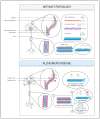Physical Exercise and Alzheimer's Disease: Effects on Pathophysiological Molecular Pathways of the Disease
- PMID: 33809300
- PMCID: PMC7999827
- DOI: 10.3390/ijms22062897
Physical Exercise and Alzheimer's Disease: Effects on Pathophysiological Molecular Pathways of the Disease
Abstract
Alzheimer's disease (AD), the most common form of neurodegenerative dementia in adults worldwide, is a multifactorial and heterogeneous disorder characterized by the interaction of genetic and epigenetic factors and the dysregulation of numerous intracellular signaling and cellular/molecular pathways. The introduction of the systems biology framework is revolutionizing the study of complex diseases by allowing the identification and integration of cellular/molecular pathways and networks of interaction. Here, we reviewed the relationship between physical activity and the next pathophysiological processes involved in the risk of developing AD, based on some crucial molecular pathways and biological process dysregulated in AD: (1) Immune system and inflammation; (2) Endothelial function and cerebrovascular insufficiency; (3) Apoptosis and cell death; (4) Intercellular communication; (5) Metabolism, oxidative stress and neurotoxicity; (6) DNA damage and repair; (7) Cytoskeleton and membrane proteins; (8) Synaptic plasticity. Moreover, we highlighted the increasingly relevant role played by advanced neuroimaging technologies, including structural/functional magnetic resonance imaging, diffusion tensor imaging, and arterial spin labelling, in exploring the link between AD and physical exercise. Regular physical exercise seems to have a protective effect against AD by inhibiting different pathophysiological molecular pathways implicated in AD.
Keywords: Alzheimer’s disease; amyloid-β peptide; molecular pathways; physical exercise; tau protein.
Conflict of interest statement
E.E. is the unique owner of 2E Science, a for-profit private scientific company. Neither E.E. nor 2E Science have any commercial interest or financial tie in relation with this article. S.L. received lecture honoraria from Roche and Servier.
Figures








References
-
- United Nations, Department of Economic and Social Affairs, Population Division . World Population Ageing 2017. United Nations Publications; New York, NY, USA: 2017.
Publication types
MeSH terms
Grants and funding
LinkOut - more resources
Full Text Sources
Other Literature Sources
Medical

